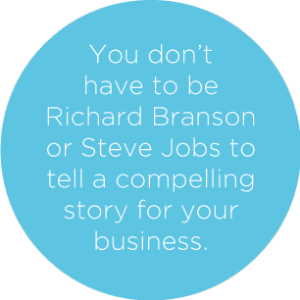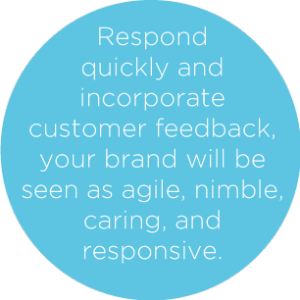The business sphere is so rife with meaningless buzzwords that it would take up most of this blog entry to list them all. But a term that most small business owners have undoubtedly heard by now that should not be chalked up to “meaningless buzz” is brand management.
What is a brand? And why is it important for your small business?
At its core, your brand is your distinguishing characteristic – your brand encompasses everything about yourself, your business, your product, how it’s delivered, and who it’s delivered to. Your brand is the key differentiating factor that sets yourself apart from your competition, for better or worse. Thusly, brand management is the work put forth by you (or by those you hire specifically for this purpose) to help establish, adapt, improve, and solidify your brand. Where do you start though?
 How to establish a meaningful company persona
How to establish a meaningful company persona
The first and most crucial step is to firmly establish what you want your brand to be about. This starts with you, the small business owner.
Who are you? What is your life story? How did you get to where you are today? Why are you in your field? What was the process that inspired you to start your own business? How do you want your business to stand out from the competition? How are you better than others in your field, and why should people choose you over your colleagues? What do you want your business to help customers achieve? By sitting down and asking yourself these key questions, you’ll begin to establish a narrative – the story that you want your customers to mentally associate with when interacting with your business.
Not everyone will have a Pulitzer Prize-winning story of how they came to open up a business, and it’s quite possible that the nature of your business (say, heating and air conditioning repair) might not lend itself to an overtly exciting history – that’s OK. You don’t have to be Richard Branson or Steve Jobs to tell a compelling story for your business.
Let your core values and beliefs shine through your small business brand
What’s important is that when going through those questions, your core values and beliefs in why your business offers a superior product or service should shine through. Maybe you had an air conditioning unit installed in your own home, were incredibly frustrated with their customer service, and wanted to provide people in your town with a better option. Maybe your father and his father before him worked for generations in the HVAC business and you are proud to carry the reins to a new generation of customers with technologically advanced units. Or maybe you’ve just been a technologically advanced tinkerer and handy person your whole life and were fascinated at a young age with the big box outside the house that cooled everyone off in the summer.
 Regardless, your motivations and goals should be clearly established in this initial stage, which will help shape your brand and what you want to put forward to the public.
Regardless, your motivations and goals should be clearly established in this initial stage, which will help shape your brand and what you want to put forward to the public.
Your brand is reinforced by how your employees interact with customers, the messages on your marketing displays, and more
Now, you should have a solid grasp on what image or persona you want to be forward facing, and have key messages established as to why your business is worth your customers’ dollars. But it doesn’t stop with just putting a great and compelling “About Us” section on your website.
 Your company’s values and ideals need to permeate throughout every aspect of your business in order to widely establish your brand. If you operate a shoe store that specializes in footwear for children and toddlers, your story about how you grew up in the slums and how you and your siblings never had proper shoes, which in turn inspired you to create affordable quality shoes for young people is FANTASTIC. But your storefront, logo, packaging, and overall ambiance have to reflect this kid- and finance-friendly attitude.
Your company’s values and ideals need to permeate throughout every aspect of your business in order to widely establish your brand. If you operate a shoe store that specializes in footwear for children and toddlers, your story about how you grew up in the slums and how you and your siblings never had proper shoes, which in turn inspired you to create affordable quality shoes for young people is FANTASTIC. But your storefront, logo, packaging, and overall ambiance have to reflect this kid- and finance-friendly attitude.
The great story behind you and your business will fall on deaf ears if it isn’t reverberated throughout every aspect of your business. Create a play room area for kids while their parents look for great deals on sneakers. Be flexible with financing options because you personally know how hard it can be as a child in a family that struggles to pay the bills. Your logo, slogan, advertisements, and every aspect of your business needs to sync up with the narrative and company persona you first established by asking yourself the above questions.
How to get your small business brand to the people
So you have a solid narrative, and you’ve also made sure that this narrative reflects your core values and differentiating factors across all facets of your business. Now what? Well you’ve done the initial heavy lifting, but now you need to make the final push to the finish line by getting your brand exposure. There is no shortage of ways to achieve this, but we’ll cover just a few.
1. Website
First and foremost, this should be your focus. Make sure that not only your story and values are easily accessible, but that all elements of your website are in line. Website branding is both an art and a science, and if you’re not fully comfortable with establishing and implementing it, there are a wide variety of companies, firms, and freelance individuals out there that will take care of this for you…for a price. If you think you can take it on, on your own, remember that even in today’s hyper-social world, your main website still accounts for the overwhelming majority of how people discover your business online. Make sure you stand out and that your potential customers know exactly what you’re all about.
 2. Social Media
2. Social Media
Whereas a website exists as the face to your business, social media is most assuredly the mouth. By staying in touch and responding (quickly) to inbound questions, comments, or concerns on Facebook, Twitter, Yelp and the others, you are not only giving your company a voice but have an opportunity in each and every correspondence to reiterate your brand. Most importantly, you’re building a relationship with your customers and fans that will make them feel as a valuable component of your business, which they undoubtedly are.
3. Publicity/Events
While not a good fit for some businesses, most career fields have conferences and tradeshows that can be incredibly valuable to small business owners. If you’re just getting started, you might just hang back and attend a few keynote addresses and network at a few booths or exhibits. But it would be wise to think about joining a panel or speaking yourself – there is no better way to get your messaging and branding out there than to say it yourself. Odds are you’ll at least make some valuable connections and learn a thing or two, but taking the bull by the horns and being aggressive can pay dividends.
4. Stay Visible
A big part of an effective branding strategy is consistency. You have to be regularly on the collective radar in order to give your messaging its best fighting chance to sink in. Buying an ad for a week in the local newspaper is great, but it would be exponentially more effective if it appeared in at least a somewhat regular pattern. Posting new specials or deals on Facebook is tremendous, but there are a potentially huge amount of people that might not have logged on that day and missed it. Regular updates on your website, social media platforms, and consistent appearances in traditional print/radio/online ad spots will do wonders, as the more often people will see your story, your business, and your brand, the more likely they are to be a customer.
5. Poll Your Customers
 Staying in touch and gleaning feedback from your customers is an essential way to look at your business’ social media platforms and how they can help you succeed. But being a keen and attentive listener to what your clientele wants is important enough to merit its own bullet, rather than a sub point under social media. Quickly responding to complaints and questions is one thing, but making the effort to implement those that are helpful is another step entirely. If somebody Tweets out that they would like to see more variety in your menu, it’s worth a response thanking them for their feedback and that you’ll look into it. If 20 people re-Tweet it, then it’s something you should seriously consider undertaking.
Staying in touch and gleaning feedback from your customers is an essential way to look at your business’ social media platforms and how they can help you succeed. But being a keen and attentive listener to what your clientele wants is important enough to merit its own bullet, rather than a sub point under social media. Quickly responding to complaints and questions is one thing, but making the effort to implement those that are helpful is another step entirely. If somebody Tweets out that they would like to see more variety in your menu, it’s worth a response thanking them for their feedback and that you’ll look into it. If 20 people re-Tweet it, then it’s something you should seriously consider undertaking.
In days past, unsatisfied customers had to resort to writing a letter, dialing the phone, or coming into your place of business to complain in person. Now, they can do it with a few presses on their smartphone screen in a matter of seconds, and the whole world sees their gripe. By responding quickly and incorporating customer feedback, you and your company will be seen as agile, nimble, caring, and responsive, which will further engender your brand.
Focusing on improving your small business brand adds to your bottom line
Just how important is brand management? According to Reputations Corporations, a whopping 72% of customers reported that a company’s reputation (brand) factored into their purchasing decisions. Moreover, 80% of potential employees would be willing to receive less money on their paycheck if it meant working for a business that holds a good reputation. And a staggering 89% of those surveyed say that overall brand is one of the biggest tiebreakers that factor into purchasing two or more equal products. Establishing your brand and pushing it forward will not only help define your small business, but it could very well be the difference between success and failure.






Leave a Comment